Review and characteristics of the best potato varieties for Western and Eastern Siberia: the earliest and most productive
If earlier in Siberia it was quite difficult to grow a full-fledged crop of any vegetable crops and often simply impossible, now, thanks to the selection work of the largest universities and agricultural academies of the country and the world, special varieties of potatoes have been developed for Siberia (Western and Eastern).
Among the many varieties of this popular crop on offer, each gardener will be able to find the most suitable one for his needs and capabilities.
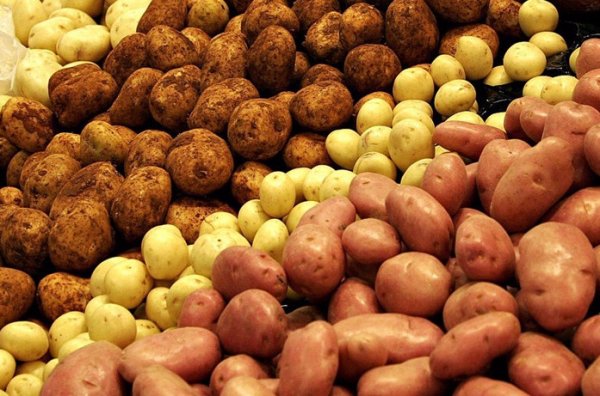
Content
- 1 What varieties of potatoes are suitable for growing in Siberia (Western and Eastern)
- 2 The best potato varieties for Western Siberia: top-16
- 2.1 Adretta
- 2.2 Alyona
- 2.3 Zhukovsky early
- 2.4 Zekura
- 2.5 Kamensky
- 2.6 Queen Anne
- 2.7 Lugovskoy
- 2.8 Lyubava
- 2.9 Meteor
- 2.10 Nevsky
- 2.11 Rosara
- 2.12 Roco (Rocco)
- 2.13 Ryabinushka
- 2.14 Sante (Santa)
- 2.15 Svitanok Kiev
- 2.16 Tuleyevsky
- 2.17 Other varieties for Western Siberia (briefly, without description and characteristics)
- 3 The best potato varieties for Eastern Siberia: top-8
What varieties of potatoes are suitable for growing in Siberia (Western and Eastern)
Although the Siberian climate is called harsh (late spring and early autumn frosts, short summer), and in Eastern Siberia the thermometer really does not rise high even in summer, it can be quite hot in Western Siberia (up to +30 degrees), which means that for each region will have their own zoned potato varieties.
Of course, the Siberian region can hardly be called favorable for growing potatoes, therefore, for planting, only special varieties are required that have good resistance to adverse weather conditions. But this does not at all mean that you need to choose only early varieties; many mid-early and even mid-season varieties (for example, Aurora, Lugovskoy, etc.) are quite suitable. In addition, it is worth considering such an important characteristic as the culinary type of the variety, in other words, for what purposes the potatoes will be used: for making soups, salads, mashed potatoes, cooking, frying or producing french fries, chips.
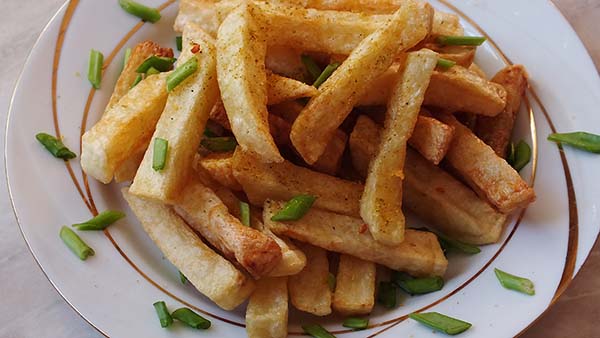
The West Siberian region includes the following subjects*:
- Altai Republic;
- Altai region;
- Kemerovo region;
- Novosibirsk region;
- Omsk region;
- Tomsk region;
- Tyumen region.
Note! Cultivars suitable for growing in the West Siberian region are not always suitable for planting in the East Siberian *.
That is why the selection of potato varieties for Western Siberia is much more extensive than for Eastern Siberia.
The East Siberian region includes these subjects*:
- The Republic of Buryatia;
- Irkutsk region;
- Krasnoyarsk region;
- The Republic of Sakha (Yakutia);
- Tyva Republic;
- The Republic of Khakassia;
- Transbaikal region.
*Important! The data are presented in accordance with the classification by regions of admission of the Federal State Budgetary Institution "State Commission of the Russian Federation for Testing and Protection of Breeding Achievements".
It is also worth knowing that, according to the classification of this government agency, the Tyumen region is included in the West Siberian, and the Sverdlovsk region in the Volga-Vyatka regions of admission.
The Ural region includes only the following subjects: the Republic of Bashkortostan, Kurgan, Orenburg, Chelyabinsk regions.
The best potato varieties for Western Siberia: top-16
Western Siberia is a more favorable region (with a continental climate) for growing potatoes, which means that there are quite enough suitable potato varieties.
Next, we will consider in detail the most popular potato varieties (their descriptions and characteristics), which are allowed for planting and growing in Western Siberia (alphabetically):
Adretta
An early variety, for table use, high-yielding, excellent taste.
The variety is distinguished by its stable annual yield, very fast initial development, strong tops and early tuberization.
It gives good results when grown on different types of soil, but areas that are too dry or often change their moisture are not suitable for it.
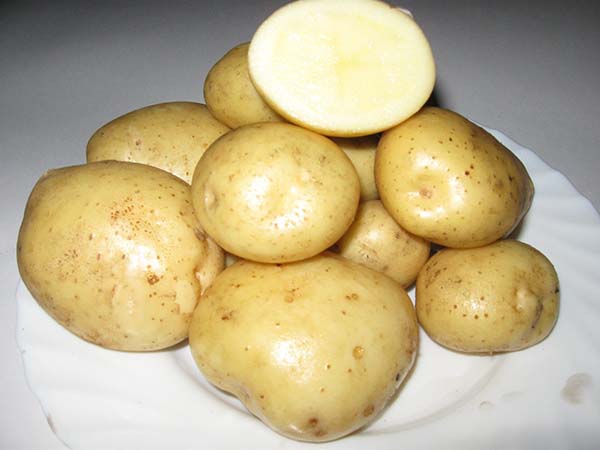
Adretta has increased resistance to common diseases of the culture, and also perfectly tolerates adverse weather conditions (resistant to short-term frosts). Therefore, tubers can be planted already in late April or early May, without fear of return spring frosts.
Important! Increased soil moisture and moisture stagnation negatively affect the tubers. Ripe fruits start to rot in moist soil.
Resistant to cancer, relatively resistant to viruses, but susceptible to late blight, common scab, rhizoctonia.
The taste of the variety is simply excellent, so it can be used in many dishes. Potatoes boil very well during cooking. Culinary type C. Suitable for cooking. For mashed potatoes, just the perfect variety, you don't even need to put oil.
Note! Adretta (however, like almost all potato varieties) needs regular renewal of planting material every 3-5 years.
Characteristics of the Adretta variety:
- ripening period - 70-80 days (early), according to other sources - 80-90 days (mid-early);
- tubers - from round-oval to oval;
- the structure of the peel is mesh;
- peel color - yellow;
- pulp color - light yellow;
- the depth of the eyes is shallow;
- starch content - 13-18%;
- yield per hundred square meters - 200-450 kg per one hundred square meters (according to other sources - 214-396 kg);
- the number of tubers in a bush - 15-25 pieces (from medium to high);
- the average weight of 1 tuber is 100-150 g;
- marketability - high;
- keeping quality - 98%.
The appearance of the plant is erect, tall, has light green large leaves, the color of the flowers is white.
Recommended for planting regions: Middle Volga, West Siberian and Far Eastern.
Patent holder or originator of the variety: Norika Nordring Kartoffelzucht und Vermehrungs GmbH (Germany).
Alyona
An early variety, for table use, good yield and taste.
The variety has a stable yield, a consistent return of early production, drought tolerance and suitability for mechanized cultivation technology.
Responds very well to germination.
Resistant to the causative agent of potato cancer. Susceptible to nematode and late blight. Resistant to common scab, rhizoctonia.
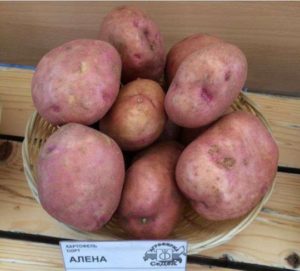
The taste is good. Culinary type VS. The digestibility is moderate. The pulp does not darken. Suitable for soups, frying. Suitable for making crispy potatoes and French fries.
Characteristics of the Alena variety:
- ripening period - early (70-80 days);
- tubers are oval;
- the structure of the peel is smooth;
- peel color - red;
- the color of the pulp is white;
- the depth of the eyes is shallow;
- starch content - 15-17%;
- yield per hundred square meters - 172-292 kg (maximum up to 391 kg);
- the number of tubers per bush - 6-10;
- the average weight of 1 tuber is 86-167 g;
- marketability - 81-97%;
- keeping quality - 95%.
The appearance of the plant - bushes of medium height, intermediate type, spreading. The leaf is large, wide, green. No or very slight waviness in the edge. Inflorescences are medium-sized, reddish-purple. Berry formation is very rare.
Recommended for planting regions: Volgo-Vyatka, Ural, West Siberian, East Siberian, Far East.
Patent holder and / or originator of the variety: Federal State Budgetary Scientific Institution "Omsk ANC" (Russia).
Zhukovsky early
An early variety for table use, high yield and medium flavor.
It perfectly adapts to changing climatic conditions, is relatively heat and drought resistant. The yield is stable.
Important! Zhukovsky grows amicably even in poorly warmed soil, so the variety can be safely planted at the end of April.
Resistant to potato crayfish and nematodes. Susceptible to tops and tubers to the causative agent of late blight. The tubers are resistant to mechanical damage.
The taste is satisfactory and good. Culinary type B. The boil-off is weak. During the cooking process, the pulp darkens slightly. Great for frying, making French fries, and making chips. Can be used for puree and cooking, but not very suitable.
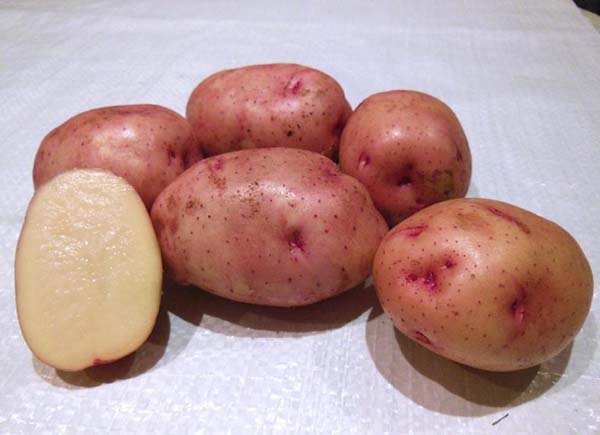
Characteristics of the early Zhukovsky variety:
- ripening period - early (70-80 days), according to other sources, very early (60-80 days);
- the tubers are oval-round;
- the structure of the peel is smooth;
- peel color - pink;
- the color of the pulp is white;
- the depth of the eyes is shallow;
- starch content - 10-12%;
- yield per one hundred square meters - 400-450 kg;
- the number of tubers per bush - 9-15;
- the average weight of 1 tuber is 100-120 g;
- marketability - 90-92%;
- keeping quality is good.
Appearance - bushes of medium height, semi-spreading stem type, the leaf is small, green (glossy), the flowers have a red-violet hue. Berry formation is rare.
Recommended for planting regions: North-West, Central, Volgo-Vyatka, Central black earth, North Caucasian, Middle Volga, Nizhnevolzhsky, Ural, West Siberian, Far East.
Patent holder and / or originator of the variety: FGBNU “All-Russian Research Institute of Potato Farming named after A.G. Lorkha (Russia).
Zekura
Medium early variety, for table use, good yield and taste.
It gained its popularity due to its undemanding care and stability of the crop, even in the conditions of the short Siberian summer.
It responds well to watering and loosening wet soil; during the period of tops formation, it is important to remove weeds in a timely manner. Drought-resistant, but at the same time suitable for soils with high humidity.
Resistant to cancer and potato nematode. It is not very susceptible to the leaf-rolling virus, weakly affected by the virus "U" and "A", late blight of leaves and tubers, scab and glandular spot.
Taste good or great. Suitable for the production of potato products (chips, fries). Cooking is medium, suitable for both mashed potatoes and soups.
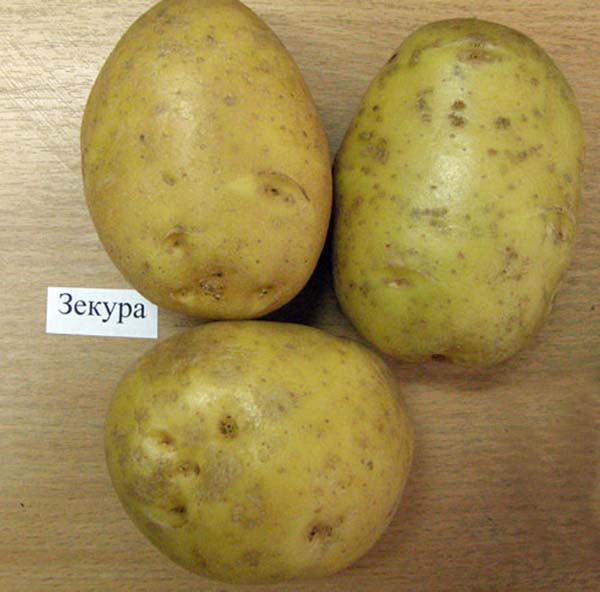
Characteristics of the Zekura variety:
- ripening period - medium early (80-90 days);
- tubers shape - oblong;
- the structure of the peel is smooth;
- peel color - yellow;
- the color of the pulp is yellow;
- the depth of the eyes is shallow;
- starch content - 13.0-18.2%;
- yield per hundred square meters - 195-323 kg (maximum up to 365 kg);
- the number of tubers per bush - 17-20;
- the average weight of 1 tuber is 59-150 g;
- marketability - 79-96%;
- keeping quality is good.
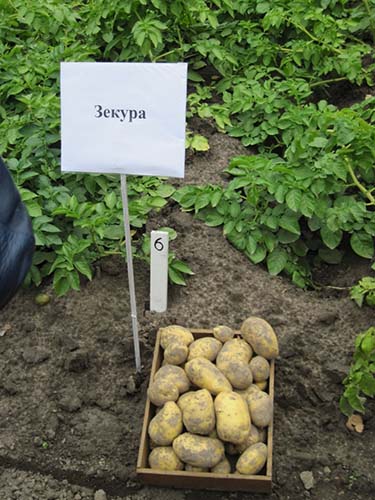
The appearance of the bush is of medium height, semi-erect, intermediate type. Inflorescences are red-purple. The base of the sprout is red-violet.
Recommended for planting regions: Volgo-Vyatka, TsChO, North Caucasian, Middle Volga, West Siberian, Far Eastern.
Patent holder and / or originator of the variety: Solana GmbH & Co.KG (Germany).
Kamensky
The variety is early maturing, for table use, medium yield and good taste.
It is characterized by early harvest accumulation and leveled tubers with high marketability.
It adapts well to all types of soil. Differs in drought resistance due to the early formation of tubers. Requires loosening of the soil, responds positively to fertilization and watering. The tough leaves of adult plants do not like the Colorado potato beetle.
Resistant to the causative agent of potato cancer. Susceptible to nematode. Medium resistant to late blight pathogen, resistant to wrinkled and banded mosaics, leaf twisting, common scab and rhizoctonia.
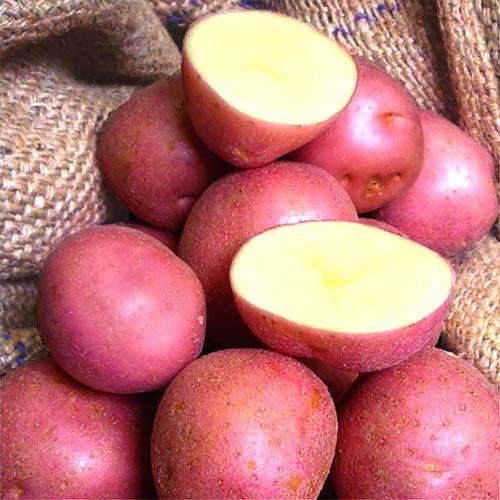
The taste is good. Culinary type B (poor digestibility).
Variety characteristics:
- ripening period - early (70-80 days);
- the shape of the tubers is elongated-oval;
- the structure of the peel is smooth;
- peel color - red;
- pulp color - light yellow;
- the depth of the eyes is shallow;
- starch content - 12.2-16.8%;
- yield per hundred square meters - 185 kg (maximum up to 252 kg);
- the number of tubers per bush - 15-25;
- the average weight of 1 tuber is 96-108 g;
- marketability - 85-94%;
- keeping quality - 97%.
The appearance of the plant is of an intermediate type, semi-erect. Medium leaf, intermediate type, dark green. Strong edge waviness. The intensity of the anthocyanin coloration of the inner side of the corolla is from medium to strong, the proportion of blue is absent or very small. The inflorescences are large. and red and purple. Berry formation is rare.
Recommended for planting regions: Volgo-Vyatka, Ural, West Siberian.
Patentee and / or originator of the variety: FGBNU "Ural Research Institute of Agriculture" (Russia).
Queen Anne
An early variety for table use, high yield, excellent taste.
Interesting! This particular variety is grown by the President of the Republic of Belarus Alexander Grigorievich Lukashenko in his residence "Drozdy".
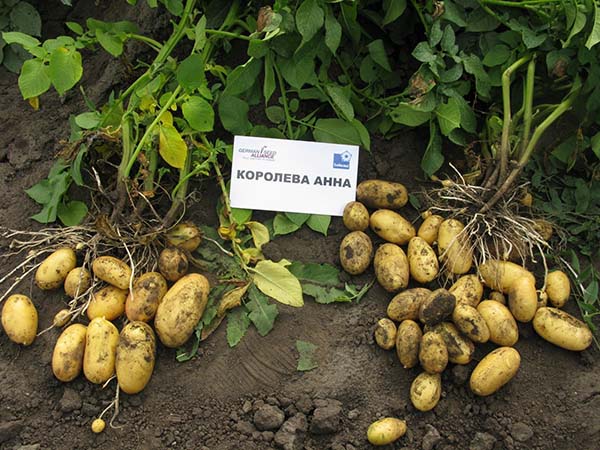
Pre-germination and planting in warm soil is desirable.
Note! When grown in arid regions, it needs abundant watering.
Resistant to the causative agent of potato cancer, golden potato cyst nematode. Resistant to wrinkled striped mosaics and leaf curling. Transport transfers without loss of marketability.
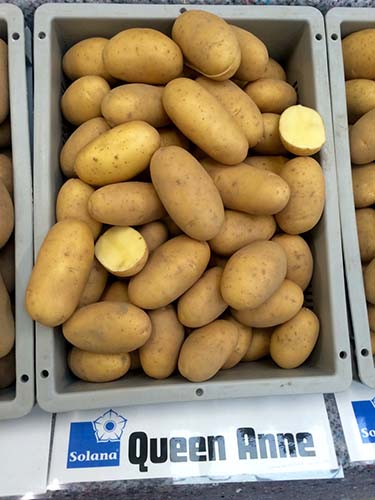
The variety has an excellent taste. Does not darken, does not boil over (weak). Recommended for frying, making soups, salads.
Characteristics of the Koroleva Anna variety:
- ripening period - early (70-80 days);
- the shape of the tubers is elongated-oval;
- the structure of the peel is smooth;
- peel color - yellow;
- the color of the pulp is yellow;
- the depth of the eyes is very shallow or shallow;
- starch content - 13.1-14.4%;
- yield per hundred square meters - 113-304 kg (maximum up to 495 kg);
- the number of tubers per bush - 6-16;
- the average weight of 1 tuber is 84-137 g;
- marketability - 82-96%;
- keeping quality - 93%.
The appearance of the plant is of medium height, stem type, has semi-spreading shoots. Leaves are medium or large, closed, green. Inflorescences are white.
Regions recommended for planting: North-West, Central, Volgo-Vyatka, Central Black Earth Region, North Caucasian, Middle Volga, West Siberian, East Siberian.
Patent holder and / or originator of the variety: Solana GmbH & Co. KG (Germany).
Lugovskoy
Mid-season growth, table purpose, high yield, good taste.
It is characterized by a stable yield. Can be grown in almost any climatic conditions.
In the process of cultivation, it responds well to hilling and deep loosening of the soil.
Resistant to cancer, relatively resistant to late blight, common scab, moderately resistant to viruses, blackleg.
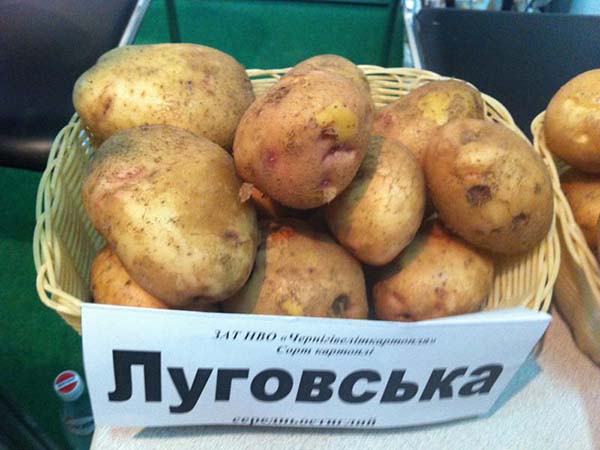
The taste is good, without excessive dryness and wateriness. The pulp does not darken. Lugovsky is recommended for making mashed potatoes and getting starch.
Characteristics of the Lugovskoy variety:
- ripening period - mid-season (90-110 days);
- tubers are oval;
- the structure of the peel is mesh;
- peel color - light pink;
- the color of the pulp is white;
- the depth of the eyes is shallow;
- starch content - 12-19%;
- yield per hundred square meters - high (maximum up to 514 kg);
- the number of tubers per bush - 10-15;
- the average weight of 1 tuber is 85-125 g;
- marketability - high;
- keeping quality is good.
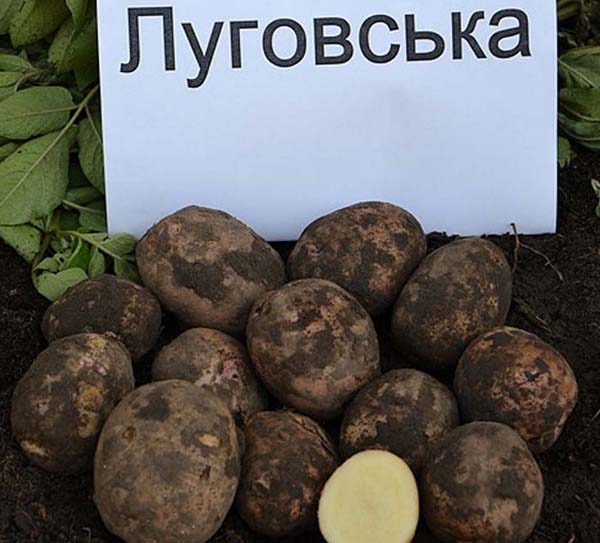
The appearance of the plant is erect, of medium height, the color of the flowers is white.
Recommended for planting regions: North, North-West, Central, Volgo-Vyatka, Central Black Earth Region, North Caucasian, Nizhnevolzhsky, Ural, West Siberian, East Siberian, Far East.
Patent holder and / or originator of the variety: Institute of Potato Growing UAAS (Ukraine).
Lyubava
An early variety, for table use, high yield, good taste. Culinary type A (salad type). Does not boil over. The pulp darkens moderately during cooking.
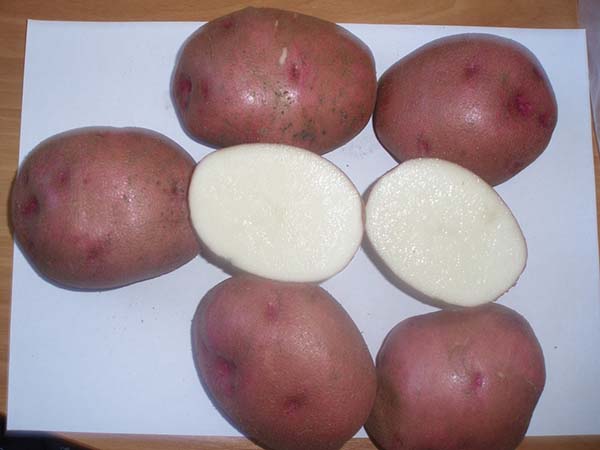
Resistant to the causative agent of potato cancer, rhizoctonia, susceptible to nematode. It is also susceptible in terms of tops and moderately resistant in tubers to the causative agent of late blight. Moderately resistant to common scab.
Characteristics of the Lyubava variety:
- ripening period - early (70-80 days);
- the shape of the tubers is oval-round;
- the structure of the peel is from medium to coarse (according to other sources, it is generally suitable, but flaky at the top);
- peel color - red;
- the color of the pulp is white;
- the depth of the eyes is average;
- starch content - 11.2-16.9%;
- yield per hundred square meters - 288-400 kg (maximum up to 524 kg);
- the number of tubers per bush - 8-15;
- the average weight of 1 tuber is 109-210 g;
- marketability - 80-98%;
- keeping quality is good.
The appearance of the bushes is of medium height, intermediate type, semi-erect. The leaf is small, open, light green. The waviness of the edge is weak. Average gloss. Inflorescences are medium-sized, reddish-purple. Berry formation is rare.
Recommended for planting regions: Ural, West Siberian, East Siberian, Far East.
Patent holder and / or originator of the variety: FGBNU “All-Russian Research Institute of Potato Farming named after A.G. Lorkha (Russia).
Meteor
Very early variety, for table use, high yield, good taste.
Good adaptability to any agro-climatic conditions, heat and drought resistance. It prefers to grow on loamy soil.
Resistant to the causative agent of potato cancer, nematode. Relatively resistant in leaves and highly resistant in tubers to the causative agent of late blight, moderately resistant to wrinkled and banded mosaics, common scab and rhizoctonia. Resistant to mechanical damage.
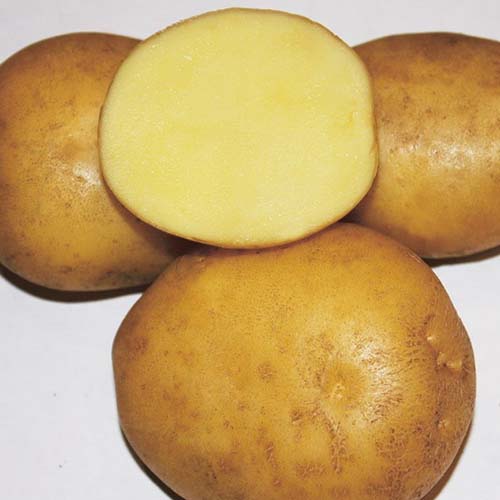
It is characterized by good taste and low digestibility. Culinary type VS.The pulp does not darken during cooking. Suitable for all kinds of dishes. Recommended for frying and baking.
Characteristics of the Meteor variety:
- ripening period - very early (60-80 days);
- the shape of the tubers is oval-round;
- the structure of the peel is smooth;
- peel color - yellow;
- pulp color - light yellow;
- the depth of the eyes is shallow to medium;
- starch content - 12.0-14.9%;
- yield per hundred square meters - 209-404 kg (maximum up to 450 kg);
- the number of tubers per bush - 10-12;
- the average weight of 1 tuber is 102-147 g;
- marketability - 88-98%;
- keeping quality - 95%.
The appearance of the plant is tall, intermediate type, semi-erect. Medium-sized leaf, dark green. The intensity of anthocyanin coloration on the inner side of the corolla is absent or very weak. Inflorescences are small, white. Berry formation is rare.
Recommended for planting regions: Central, Volgo-Vyatka, TsChO, Srednevolzhsky, Uralsky, West Siberian, Far Eastern.
Patent holder and / or originator of the variety: FGBNU “All-Russian Research Institute of Potato Farming named after A.G. Lorkha (Russia).
Nevsky
Medium early variety, for table use, high yield and average (satisfactory) taste.
By the way! According to some sources, the most popular potato variety in Russia.
Suitable for all regions. Nevsky gives good results when grown on sandy loam and loamy soils with a deep arable layer. Resistant to drought and waterlogging.
Important! When planting, it requires preliminary warming up of the seed (you can not plant it directly into cold soil), it is sensitive to the breaking off of sprouts. Responds well to plentiful feeding. To avoid scab damage, requires moist soil at the time of tuber formation.
Resistant to the causative agent of potato cancer, rhizoctonia, potato viruses. Moderately resistant to common scab. Moderately susceptible to late blight in tops and tubers. Resistant to mechanical damage. However, tubers tend to germinate during long-term storage.
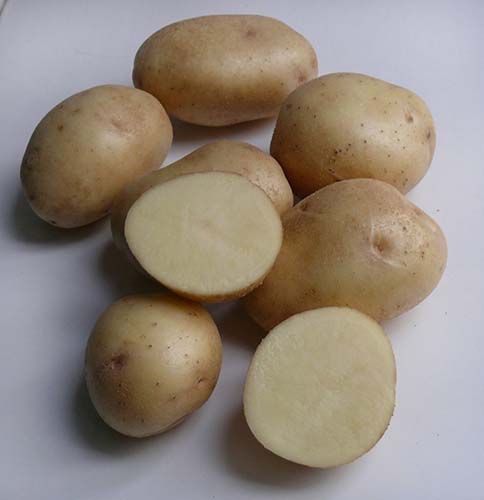
The taste is satisfactory or good. Culinary type VS. The digestibility is poor. The pulp does not darken during the cooking process. Nevsky is suitable for preparing first courses (soups) and second courses (salads), but due to its low starch content, it is not very suitable for mashed potatoes and frying.
Characteristics of the Nevsky variety:
- ripening period - medium early (80-90 days);
- the shape of the tubers is oval, aligned;
- the structure of the peel is smooth or mesh;
- peel color - light beige with pink eyes;
- the color of the pulp is white;
- the depth of the eyes is shallow;
- starch content - 10-12%;
- yield per hundred square meters - 380-500 kg;
- the number of tubers per bush - 17-20;
- the average weight of 1 tuber is 90-130 g;
- marketability - 90-95%;
- keeping quality is good.
The appearance of the plant is semi-erect, intermediate type, of medium height. The leaf is medium, light green, the edge waviness is weak. The flowers are white. Berry formation is average.
Recommended regions for planting: absolutely all regions.
Patent holder and / or originator of the variety: Federal State Budgetary Scientific Institution "Leningrad Scientific Research Institute of Agriculture" Belogorka "(Russia).
Rosara
An early variety, versatile, high-yielding, good taste.
Regardless of climatic conditions, it is able to give a stable harvest. Not damaged during transportation. It is characterized by amicable ripening of tubers.
When grown, responds well to watering, fertilization.
Resistant to cancer and potato nematode, slightly affected by late blight and common scab.
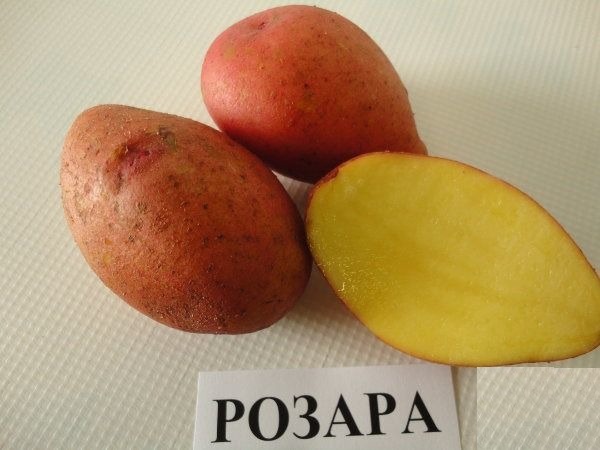
Taste good or great. In the process of cooking, it almost does not boil down, so the variety is ideal for salads, frying, cooking french fries, chips. Not suitable for mashed potatoes and cooking.
Characteristics of the Rosara variety:
- ripening period - early (70-80 days);
- tubers are oblong-oval;
- peel color - red;
- the color of the pulp is yellow;
- the depth of the eyes is shallow;
- starch content - 12.1-15.8%;
- yield per one hundred square meters - 202-310 kg (maximum up to 415 kg);
- the number of tubers per bush - 15-20;
- the average weight of 1 tuber is 81-115 g;
- marketability - 91-99%;
- keeping quality - 97% (good).
The appearance of the plant is a bush of medium height, semi-spreading. The flowers are red-purple.
Recommended for planting regions: North-West, Volgo-Vyatka, Central Black Earth Region, North Caucasian, Middle Volga, Ural, West Siberian, East Siberian, Far East.
Patent holder and / or originator of the variety: SaKa Pflanzenzucht Gbr (Germany).
Roco (Rocco)
Mid-season variety, for table use, average yield, good taste.
Differs in yield stability even under the most unfavorable conditions. Rocco prefers loamy, sandy or soddy soil with neutral acidity.
It is resistant to the causative agent of potato cancer and golden potato cyst nematode. Moderately resistant to late blight in tubers and moderately susceptible to tops. Resistant to wrinkled and striped mosaics.
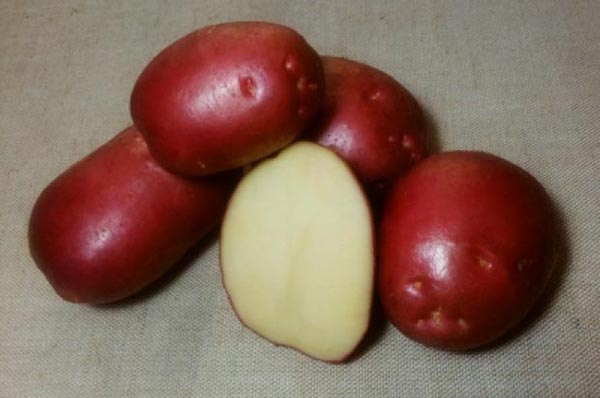
The pulp tastes good to excellent. Does not boil over during cooking. Suitable for processing into crispy potatoes, i.e. for making chips and fries.
Characteristics of the Rocco variety:
- ripening period - mid-season (90-110 days);
- tubers are oval;
- the structure of the peel is smooth;
- peel color - red;
- pulp color - cream;
- the depth of the eyes is shallow;
- starch content - 12.9-14.5%;
- yield per hundred square meters - 136-261 kg (maximum up to 275 kg); 0
- the number of tubers per bush - 8-12;
- the average weight of 1 tuber is 75-119 g;
- marketability - 84-96%;
- keeping quality - 89%.
The appearance of the plant is of medium height, intermediate type, semi-erect. The leaf is medium sized, open, green. The waviness of the edge is medium. The flowers are large, reddish-purple.
Recommended for planting regions: Volgo-Vyatka, Srednevolzhsky, West Siberian.
Patent holder and / or originator of the variety: Niederosterreicische Saatbaugenossenschaft (Austria).
Ryabinushka
Medium early variety, for table use, high yield, good taste.
The variety easily adapts to agro-climatic conditions, has a high heat and drought resistance. It responds well to watering and timely application of fertilizers. It is recommended to germinate the tubers before planting.
It is highly resistant to damage by the Colorado potato beetle. The variety is resistant to mechanical damage. Resistant to the causative agent of potato cancer and nematodes. Moderately susceptible to tops and moderately resistant to tubers to the causative agent of late blight.
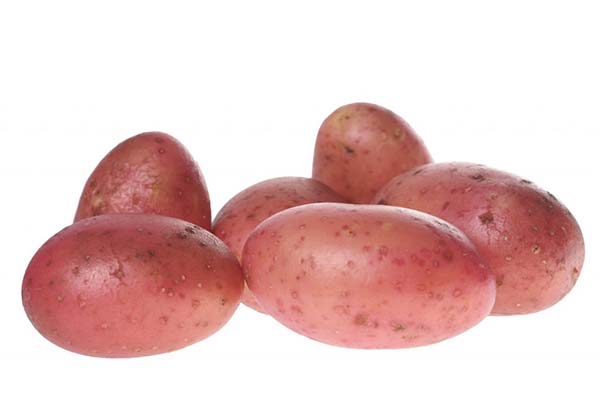
The taste is good. Culinary type B. The boil-off is weak. The pulp does not darken during cooking.
Characteristics of the Ryabinushka variety:
- ripening period - medium early (80-90 days);
- tubers are oval;
- the structure of the peel is smooth;
- peel color - red;
- pulp color - white (cream);
- the depth of the eyes is shallow;
- starch content - 11.9-15%
- yield per hundred square meters - 220-234 kg (maximum up to 396 kg);
- the number of tubers per bush - 15-18;
- the average weight of 1 tuber is 91-133 g;
- marketability - 86-96%;
- keeping quality - 90%.
The appearance of the plant is medium or tall, semi-erect. Medium or large leaves are dark green, and the inflorescences are violet-blue. Berry formation is absent.
Recommended for planting regions: North, North-West, Central, Volgo-Vyatka, Central Black Earth region, North Caucasian, Middle Volga, West Siberian, Far East.
Patent holder and / or originator of the variety: LLC Vsevolozhskaya breeding station (Russia).
Sante (Santa)
Medium early variety, versatile, high yield, good taste.
In the process of cultivation, it needs to create wide row spacings, as well as timely watering before the flowering period, since at a temperature of 29 degrees and above, the growth of shoots and tubers slows down.
Important! Planting Santa should be carried out at a soil temperature of at least 8 degrees.
It stands out for its high yield.Suitable for mechanical collection and processing, besides, it is perfectly stored and is not prone to germination.
Resistant to cancer, potato nematode, late blight, viruses, moderately resistant to common scab, susceptible to rhizoctonia.
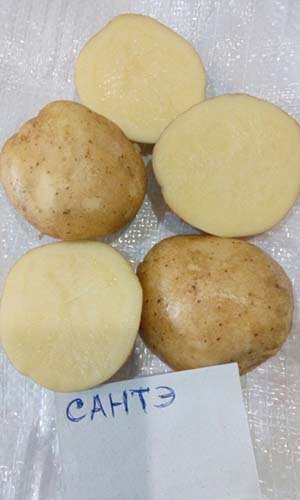
The taste of the Santa potatoes is good. The pulp does not darken during the cooking process. Suitable for frying, cooking French fries and chips. Not suitable for mashed potatoes and cooking.
Characteristics of the Sante variety:
- ripening period - medium early (80-90 days);
- tubers are oval;
- the structure of the peel is smooth;
- peel color - yellow;
- pulp color - light yellow;
- the depth of the eyes is shallow;
- starch content - 10-14%;
- yield per one hundred square meters - up to 570 kg;
- the number of tubers per bush - up to 20;
- the average weight of 1 tuber is 90-120 g;
- marketability is good
- keeping quality - 92% (good).
Santa is distinguished by erect tall shoots and white inflorescences.
Recommended for planting regions: North, North-West, Central, Volgo-Vyatka, Nizhnevolzhsky, Uralsky, West Siberian, Far East.
Patent holder and / or originator of the variety: Agrico U.A. (Holland).
Svitanok Kiev
Medium early variety, versatile, high yield, excellent taste.
It adapts to any type of soil, resistant to the Colorado potato beetle.
Resistant to potato cancer and rhizoctonia. Medium resistant to mosaic viruses, common scab, black leg. Moderately susceptible to late blight. Susceptible to nematode and leaf roll virus.
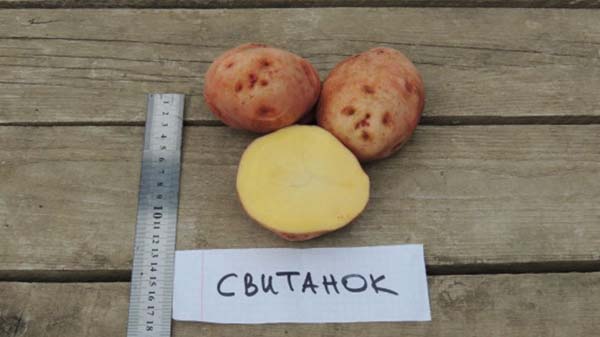
The taste is excellent. It boils well, suitable for mashed potatoes.
Characteristics of the Svitanok Kievsky variety:
- ripening period - medium early (80-90 days);
- the shape of the tubers is round;
- the structure of the peel is smooth;
- peel color - pink;
- pulp color - cream;
- the depth of the eyes is shallow;
- starch content - 16-19%;
- yield per hundred square meters - up to 460 kg;
- number of tubers per bush - 8-12
- the average weight of 1 tuber is 100-130 g;
- marketability is good;
- keeping quality - 95% (good).
The appearance of the plant is low, erect. Inflorescences are light red-violet.
Recommended for planting regions: North-West, Central, Middle Volga, Ural, West Siberian, Far East.
Patent holder and / or originator of the variety: Institute of Potato Growing UAAS (Ukraine).
Tuleyevsky
Mid-season variety, for table use, high-yielding, good taste.
Interesting! The variety is named after the governor of the Kemerovo region, Aman Gumirovich Tuleyev.
The variety reacts negatively to chemical fertilizers and watering, so it is recommended to use only humus when growing. With a lack of boron in the soil, voids appear inside the tubers. Three-fold hilling is necessary (after emergence, during flowering, after declension of tops in the aisles).
Resistant to the causative agent of potato cancer, susceptible to nematode. Moderately resistant to tops and moderately susceptible to tubers to the causative agent of late blight. The crop easily tolerates transportation, without loss of marketability (resistant to mechanical damage).
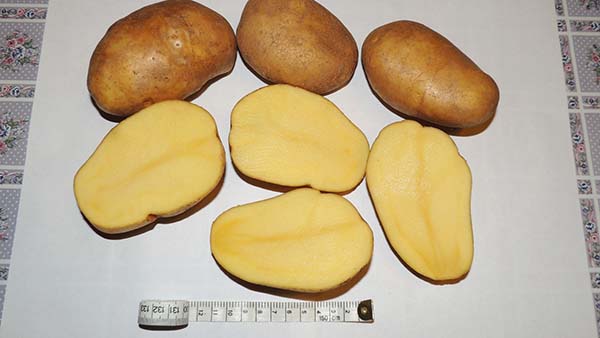
Taste good or great. Culinary type VS. Cooking is moderate, the flesh does not darken. Suitable for all kinds of dishes.
Characteristics of the Tuleyevsky variety:
- ripening period - mid-season (90-110 days), according to other sources, mid-early (80-90 days;);
- tubers are oval-elongated;
- the structure of the peel is reticulated (rough);
- peel color - yellow;
- the color of the pulp is yellow;
- the depth of the eyes is very shallow;
- starch content - 13.7-16.8%;
- yield per one hundred square meters - 180-424 kg (maximum up to 458 kg);
- the number of tubers per bush - 8-10;
- the average weight of 1 tuber is 122-270 g;
- marketability - 88-99%;
- keeping quality - 90%.
The appearance of the plant is a bush of medium height, intermediate type, semi-erect. Medium leaf, intermediate to open, dark green. Inflorescences are white.Flowering is not abundant, while the inflorescences have a purple tone with a yellow center. Berry formation is rare.
Recommended for planting regions: Volgo-Vyatka, West Siberian, East Siberian, Far East.
Patent holder and / or originator of the variety: FGBNU “All-Russian Research Institute of Potato Farming named after A.G. Lorkha (Russia).
Other varieties for Western Siberia (briefly, without description and characteristics)
Also, the following potato varieties (alphabetically) are suitable for growing in the West Siberian region:
- Antonina;
- Arosa;
- Baron;
- Bravo;
- Valentine;
- Ermak improved;
- Zlatka;
- Irbit;
- Karatop;
- Kemerovo resident;
- Ket;
- Early Krasnoyarsk;
- Kuznechanka;
- Ladozhsky;
- Lazarus;
- Leader;
- Lina;
- Suite;
- Narymka;
- Nikulinsky;
- Charm;
- In memory of Rogachev;
- Priobsky;
- Priekulsky early (Forty days); Pushkinets;
- Red Lady;
- Red Scarlet;
- Christmas;
- Sarma;
- Sarovsky;
- Sappho;
- Northern;
- September;
- Solar;
- Sotochka;
- Stemlyuk;
- Tanai;
- Tomich;
- The dashing man;
- Fresco;
- Hostess;
- Charoite;
- Evolution;
- Anniversary;
- Yuna.
The best potato varieties for Eastern Siberia: top-8
The climate in Eastern Siberia is sharply continental, so the conditions for growing potatoes are even less favorable than in Western Siberia, nevertheless, domestic and foreign breeding have developed many suitable potato varieties for such harsh conditions.
And now let's take a closer look at the most popular potato varieties (their descriptions and characteristics) that are allowed for planting and growing in Eastern Siberia (alphabetically):
Aurora
Mid-season variety, for table use, high-yielding, excellent taste.
The variety is able to adapt to any climatic growing conditions, and is also not picky about the type of soil.
Resistant to potato crayfish and nematodes, moderately resistant to viruses, moderately susceptible to the causative agent of late blight by tops and tubers.
The taste is excellent. When cooked, the potatoes become crumbly (medium boiling). Culinary type VS. Suitable for making soups and purees.
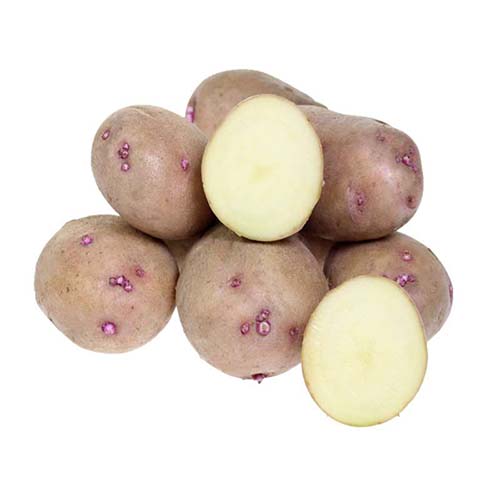
Characteristics of the Aurora variety:
- ripening period - mid-season (90-110 days);
- the shape of the tubers is oval (aligned);
- the structure of the peel is smooth;
- peel color - yellow;
- pulp color - white (cream);
- the depth of the eyes is shallow;
- starch content - 13.5-17.3%;
- yield per hundred square meters - 214-396 kg (maximum up to 416 kg);
- the number of tubers per bush - from 20-25;
- the average weight of 1 tuber is 93-128 g;
- marketability - 80-93%;
- keeping quality - 94%.
In appearance, it is distinguished by tall bushes with large foliage of a light green hue. The inflorescences have a red-purple hue. Berry formation is average.
Recommended for planting regions: North, North-West, Central, Volgo-Vyatka, TsChO, North Caucasian, Middle Volga, East Siberian, Far East.
Patent holder or originator of the variety: LLC Vsevolozhskaya breeding station (Russia).
Of the already detailed potato varieties for cultivation in Western Siberia, for planting in Eastern Siberia are also suitable:
- Alyona;
- Queen Anne;
- Lyubava;
- Lugovskoy;
- Nevsky;
- Rosara;
- Tuleyevsky.
Other varieties for Eastern Siberia (briefly, without description and characteristics)
Also, the following potato varieties are suitable for growing in the East Siberian region (alphabetically):
- Antonina;
- Aramis;
- Arosa;
- Borus 2;
- Epic of Siberia;
- Warmas;
- Spring is white;
- Volzhanin;
- Volcano;
- Kemerovo resident;
- Krasnoyarsk early;
- Lina;
- Madeline;
- Malamur;
- Mustang;
- Nakra;
- In memory of Rogachev;
- Flight;
- Priekulsky early (Forty days);
- Pushkinets;
- Red Lady;
- Sarma;
- Northern;
- Tanai;
- Tulun early;
- Felox;
- Hostess;
- Charoite;
- Yugan;
- Yakutian woman.
Note! The list of potato varieties for Siberia is made in accordance with the regions of admission of the Federal State Budgetary Institution "State Commission of the Russian Federation for Testing and Protection of Breeding Achievements".
So, all that is left for you to do now is to choose the right variety, and then even in the harsh conditions of Siberia (especially Eastern) you will be able to get good and stable yields every year.

